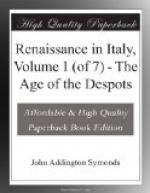[1] Lorenzo de’ Medici
superseded these two councils by the
Council of the Seventy, without,
however, suppressing them.
[2] A corruption of Scrutinio.
Varchi: Storia Fiorentina, lib. iii. caps. 20, 21, 22.
The whole city of Florence is divided into four quarters, the first of which takes in the whole of that part which is now called Beyond the Arno, and the chief church of the district gives it the name of Santo Spirito. The other three, which embrace all that is called This side the Arno, also take their names from their chief churches, and are the Quarters of Sta. Croce, Sta. Maria Novella, and San Giovanni. Each of these four quarters is divided into four gonfalons, named after the different animals or other things they carry painted on their ensigns. The quarter of Santo Spirito includes the gonfalons of the Ladder, the Shell, the Whip, and the Dragon; that of Santa Croce, the Car, the Ox, the Golden Lion, and the Wheels; that of Santa Maria Novella, the Viper, the Unicorn, the Red Lion, and the White Lion; that of San Giovanni, the Black Lion, the Dragon, the Keys, and the Vair. Now all the households and families of Florence are included and classified under these four quarters and sixteen gonfalons, so that there is no burgher of Florence who does not rank in one of the four quarters and one of the sixteen gonfalons. Each gonfalon had its standard-bearer, who carried the standard like captains of bands; and their chief office was to run with arms whenever they were called by the Gonfalonier of Justice, and to defend, each under his own ensign, the palace of the Signory, and to fight for the people’s liberty; wherefore they were called Gonfaloniers of the companies of the people, or, more briefly, from their number, the Sixteen. Now since they never assembled by themselves alone, seeing that they could not propose or carry any measure




